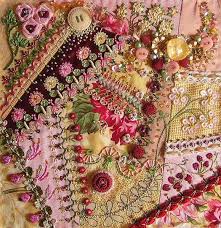Crazy Quilting: A Labor of Love
- Krista Moser

- Aug 27, 2017
- 4 min read

Today, we have a real treat! My friend, Crystal, compiled the history of the crazy quilt. She has a knack for research and a love of social history; something that has rubbed off on me through many hours of period movies and wine, when our brains are just too rummy to work anymore. She handles all the operations stuff here, everything from post office runs to cooking fantastic meals that keep us going late into the night (how else do you think we get stuff done?!). Chances are if you’ve gotten a grammatically correct communication from me, it has come through her first :) She’s just delightful, and I know you will love what she put together here.
Take it away, Crystal!
"Take your needle, my child, and work at your pattern--it will come out a rose by and by. Life is like that...one stitch at a time, taken patiently."
Oliver Wendell Holmes
Everyone loves a crazy quilt. They have a story to tell.
The Setting

My favorite time period is the Victorian era, the period of Queen Victoria’s reign from June 1837 to January 1901, more like Wives and Daughters than Downton Abbey. I love the corseted dresses with their tiny waists, the high neck blouses adorned with bits of lace and family brooches, long full skirts with high top button boots, or soft kid leather slippers, and gloves made of soft butter leather.

Homes were full of cluttered rooms chock full of bric-a-brac, with large scale potted plants, and rugs on tops of rugs, with China dogs guarding ornate fireplaces. The gentlemen class enjoyed beautiful lavish estates, ample food and wine, and endless leisure, a commodity that could not be bought. This is the fascinating and eclectic period that inspired the crazy quilt.
The newly-industrialized 19th-century textile industry made a wide variety of fabrics available, which had not been available before, to urban, upper-class women. They pieced together crazy quilts using hundreds of different fabrics in rich dark silks, lush velvets, sumptuous brocades and satins, and shiny taffetas. They used new pieces, leftovers from dress making, or pieces salvaged from worn out garments.

Crazy quilts were kept in the parlor and often referred to as slumber robes or couch throws. Traditionally made in North America, crazy quilts are made with patches of various sizes, shapes, colors, and fabric, with embellishments like embroidery. The seams and patches are heavily decorated. Crazy quilting, also called crazy patchwork, is a textile Art, not a particular type of quilting.

The Victorians remembered a departed loved one by making a crazy quilt in their memory. This was a great way to save bits of fabric as memories can be held in pieces of clothing: ties, jewelry, bits of lace, buttons, and ribbon belonging to the loved one are just a few of the materials that can be found in a crazy quilt. The quilts are then heavily embroidered, often with the dates of birth and death of the loved one: “Most beloved Mother, 1810-1884.”

History
Crazy quilts first became popular in the late 1800’s. They were inspired by the Centennial International Exhibition of 1876, the first official World's Fair in the United States, held in Philadelphia, Pennsylvania. The exhibition celebrated the 100th anniversary of the signing of the Declaration of Independence. Nearly 10 million visitors attended the exhibition and thirty-seven countries participated in it.

The exhibition opened up opportunities and sights never seen before. Some of the inventions on display included the sewing machine, typewriter, gas stove, and the Alexander Graham Bell telephone, which changed the world forever. The fair was the debut of the world's first monorail system with passenger cars straddling a single elevated iron rail that rested several feet off the ground. Visitors to the fair could also find new foods such as bananas, popcorn and Heinz ketchup, things we take for granted in our supermarkets today. Other exhibits including English embroidery with satin stitching, Japanese Art with silk screening, and crackle glazed pottery delighted American visitors. Unique patterns influenced by the crackle glaze of the pottery and the satin stitching in English embroidery began to show up in Art resembling spider webs and fans.
Crazy Quilt
The description “crazy” comes from the irregular shapes and sizes in the patches of a crazy quilt with an appearance of broken pottery like mosaics pieced into blocks and then joined together. Often a quilt is embroidered with a variety of stitches and colors; the most common is the feather stitch used to hide raw edges between the patches.
The crazy quilt was fragile, difficult to clean and rarely used as a bed covering. Though constructed as three layers, they were usually bound and tied to a backing but rarely quilted.
Though the fashion eventually declined among urban women, it continued in rural areas and small towns using the same patchwork method but utilizing sturdier and more practical fabrics.

Only women who did not have to work and had leisure time, something unheard of in the working class, had time to make a crazy quilt. The quilts enjoyed a resurgence in the crazy 60’s and early 70’s and today we have more fabric, stitching options, thread, buttons, and ribbons than ever to make an amazing crazy quilt.
Crazy quilts are truly a labor of love. How long does it take to make a crazy quilt? A Harper’s Bazaar article from 1884 estimated a full-size crazy quilt could take 1500 hours to complete.

Now, that’s c-r-a-z-y!















